| Structure | Name/CAS No. | Articles |
|---|---|---|
 |
Methylene Blue
CAS:61-73-4 |
|
 |
potassium chloride
CAS:7447-40-7 |
|
 |
Naloxone hydrochloride dihydrate
CAS:51481-60-8 |
|
 |
Isoprenaline hydrochloride
CAS:51-30-9 |